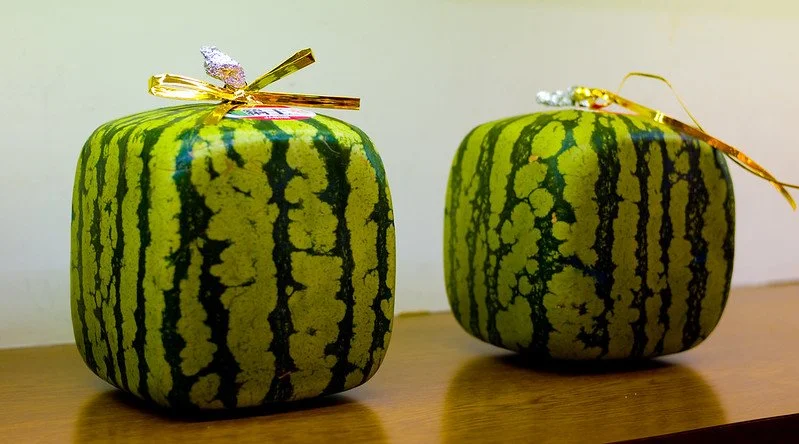Japan places cultural importance on giving fruit gifts, leading to the cultivation of impressive fruits that can cost over $100
Square Watermelon. Joi Ito. CC BY 2.0.
In most parts of the world, fruit is a relatively common food, located in every grocery store and eaten as a healthy snack. However, fruit in Japan is expensive, much more than most would expect. Every piece of fruit is carefully grown and so much importance is placed on this that a single piece of fruit can cost over $200.
Of these expensive fruits, melons are the most famous. Many watermelons are grown in the shape of a cube, though known as square watermelons, and others a heart. Square watermelons were originally developed to make it easier to store them, but they are still watermelons. Yubari melons are also extremely costly, well-known for their sweetness, texture and aroma. They are known as the most expensive fruit because in 2010, a pair of them were sold for $45,000 to a melon-flavored mineral water company celebrating their 10th anniversary. Muscat grapes are also very popular, each one large, plump and shiny. However, the Ruby Roman grapes are even more special. These are grown only in Ishikawa, one of Japan’s prefectures, and a single one of these grapes can cost 2,500 yen (about $18). They are easily the most expensive grapes in the world, but they are also the largest, with each grape as big as a ping pong ball. Though these grapes are also classified into superior, special superior and premium, only 1-2 bunches of grapes are considered premium per year. In 2020, a premium group of Ruby Roman grapes sold for $12,000. Another popular and expensive fruit is the Japanese strawberry. Amao strawberries, grown in Fukuoka, cost around $7 per kilogram, but they are roughly 4-5 times the size of normal strawberries. Hatsukoi no kaori, or white jewel strawberries, are 3 times the size of a regular strawberry, but a singular one of them will cost $10. This is because of the unique color that they are famous for. Hatsukoi no kaori are white strawberries with red seeds, hence the name “white jewel”.
White Jewel Strawberry. Jed Schmidt. CC BY-NC-SA 2.0.
These impressive fruits are expensive for a reason. There is a lot of careful cultivation by the farmers who grow them so that the fruit turn out perfectly. Each farmer has their own way of meticulously taking care of their fruit plants. Some will pollinate each flower by hand, others have hats for their fruit in order to prevent sunburn and the rest will grow the plant so that each branch or vine only has one fruit. This way, all the nutrients in the plant are directed towards that particular fruit.
Display of Expensive Fruit. The Tronodon. CC BY-NC-ND 2.0.
In addition, fruit-giving is an important part of Japanese culture. The seasons play a large cultural role, and fruit represents them because different fruits thrive better during different times of the year. It allows people to experience and appreciate what each season has to offer, from the colors of the fruit, to their aroma and, of course, taste. Beyond that, since fruit is edible, it doesn’t clutter people’s houses. Also, since the fruit is a gift, it has to look perfect. They cannot have blemishes or other imperfections, which is why so much labor and dedication is devoted to growing each luxury fruit.
Katherine Lim
Katherine is an undergraduate student at Vassar College studying English literature and Italian. She loves both reading and writing, and she hopes to pursue both in the future. With a passion for travel and nature, she wants to experience more of the world and everything it has to offer.







